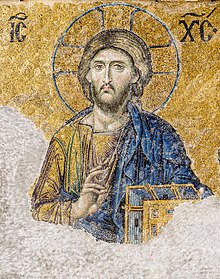Byzantine art

Byzantine art is a form of Christian Greek art of the Eastern Roman Empire (now called the Byzantine Empire) from about the 5th century to the Fall of Constantinople in 1453.[1]
However, the term can also be for other the art of countries who shared their culture with the Byzantine Empire, including Bulgaria, Serbia and Rus. The Republic of Venice and Kingdom of Sicily can also be included even though they were part of Western European culture. Art that was produced by Balkan and Anatolian Christians who lived in the Ottoman Empire is often called "post-Byzantine." Certain traditions that began in the Byzantine Empire, particularly icon painting and church architecture, are still current in Greece, Russia and other Eastern Orthodox countries.
Related pages[change | change source]
References[change | change source]
- ↑ Panayotis A. Michelis. An Aesthetic Approach to Byzantine Art. Athens: 1946.
Other websites[change | change source]
- The Glory of Byzantium. Exhibit at the Metropolitan Museum of Art.
